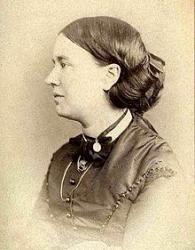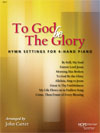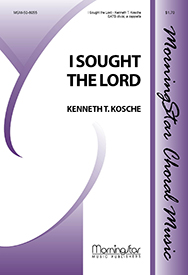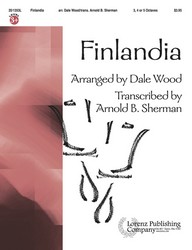- |
User Links
I sought the Lord, and afterward I knew

I sought the Lord, and afterward I knew
Author: Jean Ingelow (1878)Songs of Response
Published in 91 hymnals
Printable scores: PDFPlayable presentation: Lyrics only, lyrics + musicAudio files: MIDI, Recording
Representative Text
1 I sought the Lord, and afterward I knew
He moved my soul to seek Him, seeking me;
it was not I that found, O Savior true;
no, I was found of Thee.
2 Thou didst reach forth Thy hand and mine enfold;
I walked and sank not on the storm-vexed sea;
'twas not so much that I on Thee took hold,
as Thou, dear Lord, on me.
3 I find, I walk, I love, but O, the whole
of love is but my answer, Lord, to Thee!
For Thou wert long beforehand with my soul,
always Thou lovedst me.
Source: Psalms and Hymns to the Living God #322
Author: Jean Ingelow
 Ingelow, Jean, daughter of W. Ingelow, Boston, Lincolnshire, was born in 1820. Her writings are well and favourably known. Her poetical pieces have been published as Poems, 1863, and A Story of Doom and other Poems, 1867. From her Poems, 1863, the cento "And didst Thou love the race that loved not Thee" (Love of Christ in the Congregational Church Hymnal 1887, is taken.
--John Julian, Dictionary of Hymnology, Appendix, Part II (1907)… Go to person page >
Ingelow, Jean, daughter of W. Ingelow, Boston, Lincolnshire, was born in 1820. Her writings are well and favourably known. Her poetical pieces have been published as Poems, 1863, and A Story of Doom and other Poems, 1867. From her Poems, 1863, the cento "And didst Thou love the race that loved not Thee" (Love of Christ in the Congregational Church Hymnal 1887, is taken.
--John Julian, Dictionary of Hymnology, Appendix, Part II (1907)… Go to person page >Text Information
| First Line: | I sought the Lord, and afterward I knew |
| Author: | Jean Ingelow (1878) |
| Meter: | 10.10.10.6 |
| Source: | One Hundred Holy Songs, Carols and Sacred Ballads (London: Longmans, Green and Co.) |
| Place of Origin: | United States |
| Language: | English |
| Notes: | Spanish translation: See "Yo te busque, Señor, mas descubrí" by Federico Pagura |
| Copyright: | Public Domain |
| Liturgical Use: | Songs of Response |
Notes
Scripture References:
st. 2 = Matt 14:22-23
st. 3 = 1 John 4:10,19, Jer. 31:3
Said by some scholars to have been written in 1878, this anonymous text was published in Holy Songs, Carols, and Sacred Ballads compiled by the Roberts brothers in Boston (1880). Austin Lovelace says of this text: "'He first loved us.' This simple yet profound thought is the basis for the hymn. God loved us long before we knew it. We seek God, but already God is holding out a hand waiting for us to take hold of it and be rescued from the seas of life" (Lovelace, Hymn Notes).
Stanza 2 alludes to the scene in which Christ saves Peter from drowning (see Matt. 14:22-33).
Liturgical Use:
See PHH 496 and PHH 497.
--Psalter Hymnal Handbook
===============
Holy Songs, Carols, and Sacred Ballads published by Roberts Brothers in Boston is virtually similar to One Hundred Holy Songs, Carols and Sacred Ballads published by Longmans, Green & Co. in London in 1878. The British Library Catalogue, The Dictionary of British Women Writers (ed. Jane Todd, 1989) and Jean Ingelow, victorian Poetess (by Maureen Peters, 1972) all attribute the poem to Jean Ingelow.
From "I sought the author: a hymnological whodunnit" by Bernard Massey in Bulletin (Hymn Society of Great Britain and Ireland), Vol 17, Issue 1, No. 234, 2003, pp. 18-19
====================
I sought the Lord, and afterward I knew. [He first loved us.] An anonymous and undated hymn in The Pilgrim Hymnal 1904.
--John Julian, Dictionary of Hymnology, New Supplement (1907)
Access an additional article on the Canterbury Dictionary of Hymnology:
For Leaders
Organist and composer Austin Lovelace wrote these words about this hymn: “’He first loved us’ (PHH). This simple yet profound thought is the basis for the hymn. God loved us long before we knew it. We seek God, but already God is holding out a hand waiting for us to take hold of it and be rescued from the seas of life.” How often do we feel like we are thrusting out a hand in every which direction, trying to find something secure to hold on to amidst the stresses and trials that life throws at us? How often do we forget that there is already a hand being extended to us, waiting for us to grab hold? Do we remind ourselves daily of the love God pours out on us each day? As we sing this hymn, may the words sink deep into our hearts: “Always thou lovedst me.”
Text
This anonymous text is thought to have been written in 1878, and was first published in Holy Songs, Carols, and Sacred Ballads. The text has remained unaltered since its publication. There is something both quirky and elegant about the language used – the last stanza can be especially confusing, so it might be beneficial to your congregation to explain the general theme of this verse – that God loved us first, and all we can do to respond is to love Him in return.
Tune
There are a number of tunes that this text has been set to. Most popular is PEACE (Chadwick), followed closely behind by ARTAVIA, PEACE (Brandon), FAITH, and FINLANDIA. The different tunes used generally vary on denomination and tradition – more than a question of what tune is better, it’s simply a question of what tune has been handed down over the years. FINLANDIA is the only one that alters the text – it draws out the verses by repeating the last two lines.
Bifrost Arts has a beautiful, haunting new tune for this hymn. The instrumentation would be very difficult to recreate and isn’t very conducive for congregational singing, but the melody is quite wonderful.
Regardless of what tune you use, be careful to keep the tempo moving since the individual lines are long.
When/Why/How
This is a hymn that works well during a service of confession and assurance, acknowledging our inability to act on our own and being assured that the Lord moves within us, prompting us to grow closer to Him. When focusing on God’s active work to seek us out, think about framing the hymn with a reading of Psalm 139, which echoes much of that theme. A very Reformed hymn, this could also be sung after a sermon on the doctrine of election.
Scripture Passages:
- Matt. 14: 29-31 – “Then Peter got down out of the boat, walked on the water and came toward Jesus. But when he saw the wind, he was afraid and, beginning to sink, cried out, ‘Lord, save me!’ Immediately Jesus reached out his hand and caught him. ‘You of little faith,’ he said, ‘why did you doubt?’”
- 1 John 4:10 – “This is love: not that we loved God, but that he loved us and sent his Son as an atoning sacrifice for our sins.”
- 1 John 4:19 –“We love because he first loved us.”
- Jer. 31:3 – “The LORD appeared to us in the past, saying: ‘I have loved you with an everlasting love; I have drawn you with unfailing kindness.’”
- Psalm 139 – “…Before a word is on my tongue you, LORD, know it completely. You hem me in behind and before, and you lay your hand upon me…”
Laura de Jong Hymnary.org


 My Starred Hymns
My Starred Hymns





